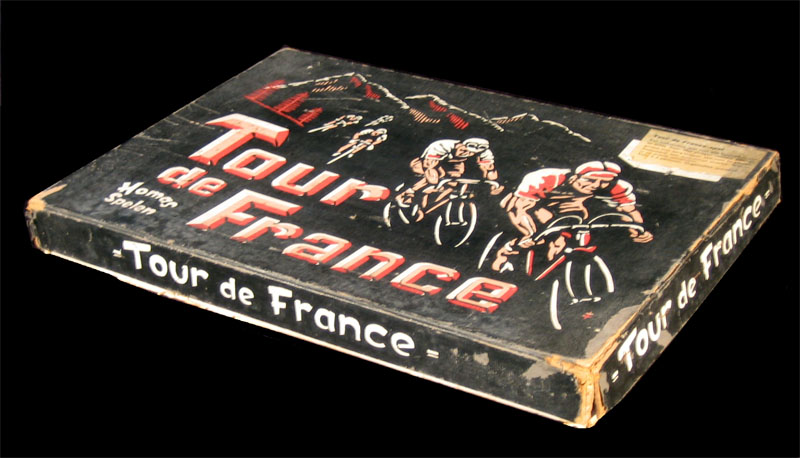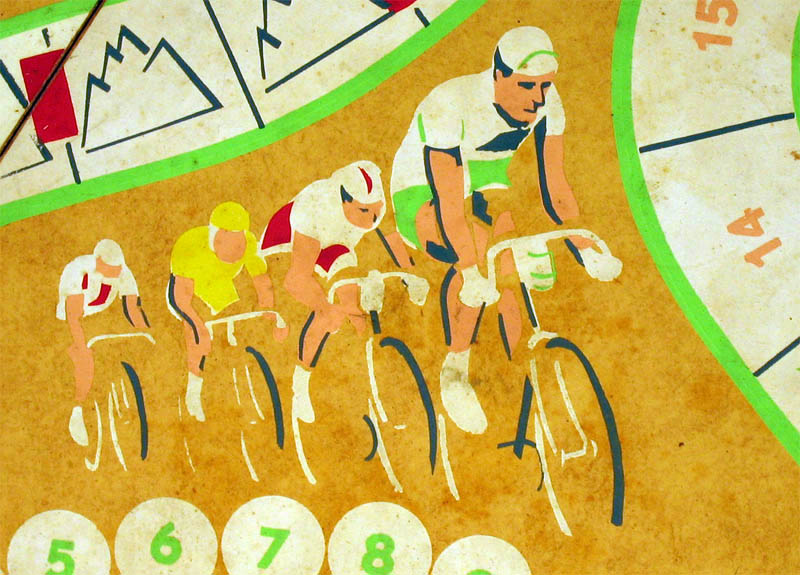
TOUR DE FRANCE
Homas Spelen, Netherlands, ca.
1966

One of my all-time favorites. Although in purity it is "just another dice game" (as some harcore gamers would say) and, of course, luck takes a big part in it, this one has something special. Starting with the wooden board. (What a pity the cyclists are simple wooden pegs!).
This game is big and heavy. The board consists of 6 wooden panel and measures a total of 90 x 75 cm. You need a big playing table. What's worse. the game weights 3.2 kg. It can be expensive if you have to mail it overseas!

Unfortunately (for us non Dutch-speaking), the rules are exclusively in Dutch, so for quite a long tome I was unable to play it. After a while, I tried to translate it with babelfish, but the result was not so good.... Fortunately, Maarten Nacimovic was kind enough to send an English translation, so now I have something readable. In case someone needs the translated rules, contact me.
The rules, by the way, are quite interesting. Each player manages a team of seven riders (at the beginning of the Tour) for which he throws as seven dice, in the following manner. He throws three dice, decides which riders he moves with them. Then he throws three dice more, and moves three other riders. Finally he throws the last die and moves the last rider. He has to use some strategy to avoid the pitfalls in the road (falls and punctures) and fall on the bonus squares. What's more interesting, there is a mark in every stage that riders have to reach or else they are eliminated from the Tour. As the race goes on, more and more riders are eliminated, and teams have less riders to throw (always in triplets), therefore less tactical options.
From my experience, most if not all teams end the race wth just two riders (the minimum according to the rules: the riders are not eliminated anymore when the team is reduced to two riders), which is a weakness in the game, since the tactical interest is lost at that point and the last stages become just a throw-and-move game.
A close-up of the main defect of this game: no cyclists...

Points for the general classification are awarded to the first 5 riders in each stage, as well as money prizes. There is also a team classification for which independent points are awarded (and more money). The leaders of each classification get more money after each stage, and even more after the final stage. Bonus fields also give money to the players while punctures cost money. The winner of the game is the player with more money at the end of the Tour. As can be expected, it is very difficult to win the game if you do not win at least one of the classifications.
Professional cycling

There are six stages plus two time-trials. The time-trials are pure-luck stages, count only for the team classification, and the time limit is quite hard to reach. Specially in the first of the two time trials, a lot of riders have to quit the Tour.
Stages 3, 4 and 5 are mountain stages. The mountain rule is quite simple (a rider on a mountain field uses half of the throw, rounded up) and does not work specially well in the game.
The fields marked with an ambulance are a severe fall and the rider falling on them has to quit the race. The first ambulance in the race (10th field in the first stage) is particularly dramatic since a compact peloton of 35 riders is inevitably decimated by a mass fall. In fact, the first stage has a Paris-Roubaix flavour...
Nevertheless, when a team has been reduced to two riders and no more eliminations are possible, riders get their revenge over ambulances, as theyrun over them with impunity.
An additional rule is that when you get a throw of three dice with consecutive values (e.g.: 3, 4, 5) you move three riders accordingly plus you distribute the highest throw (in this case 5) between those three riders for an extra advance. This rule looks simple but turns out to be quite messy when actually played.
Fantastic graphics everywhere



The game is quite long to play. It may take almost three hours to complete the six stages, even though things get quicker as the peloton gets smaller. The last stages are quite quick and sadly rather uninteresting.
However, all things considered, the game remains a personal favourite.
I used to think this game was from the end of the 1950s, but the invaluable HONGS website displays a 1966 Homas catalogue in which the game is presented as a new game (thanks Kevin for the tip!), so I have to reconsider my estimation. By the way, at the moment of writing BGG dates this game (incorrectly, I am afraid) as being of 1961.
By the way, some years ago I received a letter from Harry Hommes, son of the developer of this game, about the family background concerning the Homas factory. You can read it in the "making cycling games" section of the site, and check the pictures he also sent.
 |
 |
 |
 |
 |
|
CULTURE IDEAS |
TOTUM REVOLUTUM THUMBNAILS |
NAMES ALPHABETICAL |
CATEGORIES LISTS |
WHAT'S NEW BLOG |